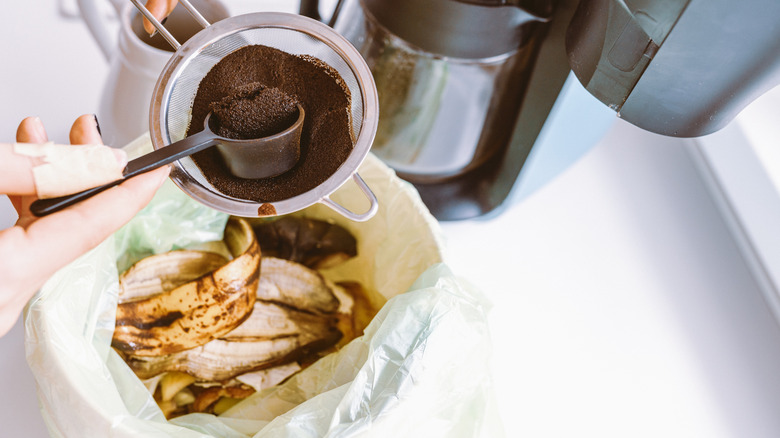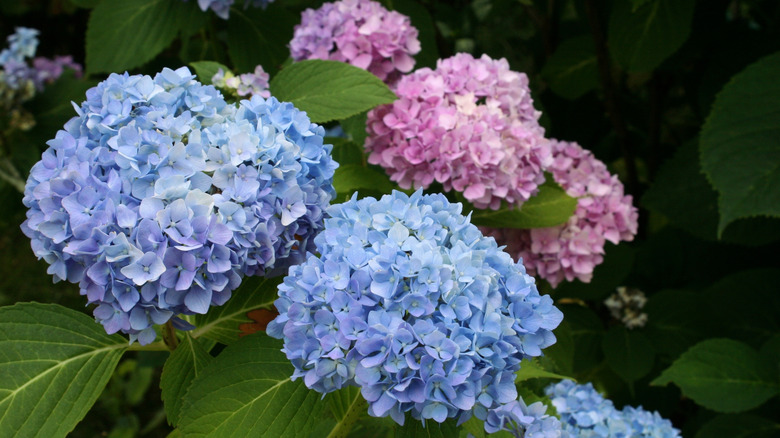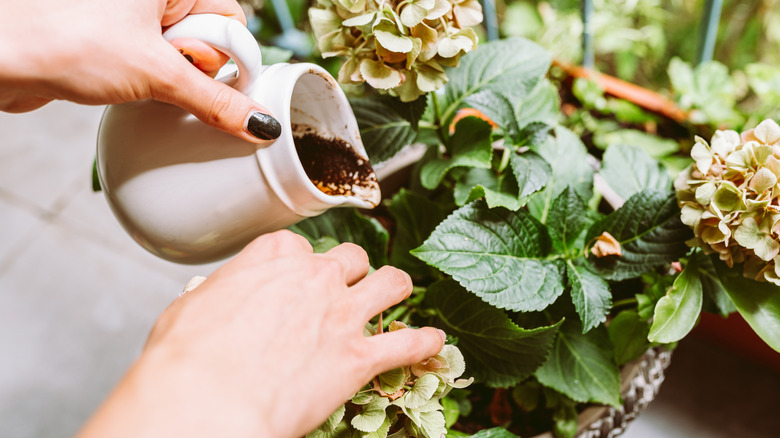Why You Should Consider Reaching For Coffee Grounds When Growing Hydrangeas
Hydrangeas are such inspiring plants to have in your garden. They might look a little drab over the colder months, but once spring arrives, they come back to life with their big leaves and add a much-needed touch of greenery to your yard. As you watch them grow, you start to see those large flower heads forming and, before you know it, your yard comes alive with glorious color. There's nothing more rewarding than admiring those impressive blooms and cutting just a few to put into a vase indoors. But, what if you yearn for a bit more blue in your outdoor space, instead of the pink blooms your hydrangeas are presenting you with? If you happen to be growing either bigleaf or mountain hydrangeas, you can change the color of your flowers with a common kitchen waste product: coffee grounds.
Commonly, gardeners have applied sulfur to decrease the pH of the soil, which can result in blue hydrangeas. This means that if yours are pink, your soil is most likely on the alkaline side. In other words, to turn your hydrangeas blue, you'll want to acidify the soil, and using coffee grounds will help. Like compost, coffee grounds can assist in lowering the soil pH, making it slightly more acidic over time. It's actually the aluminum in the soil that affects the bloom color, and you'll find that in acidic soils, this compound is much more readily available for the plant roots to absorb.
How to use coffee grounds to change the color of your hydrangeas
The best time to amend your soil and change the color of your hydrangeas is in early spring, just before the flower buds start developing. However, as it might take a little more time for the grounds to have an effect on the soil, you may want to start adding them in the fall and reapplying small amounts on a monthly basis. It's best to use freshly brewed grounds around your hydrangeas, but let them dry a little first, so you don't get mold growing. Spread the grounds around the base of your plants and lightly rake them into the soil.
Avoid just dumping them on top of the soil because the fine particles can form a solid crust, which will prevent water from soaking down into the ground. It's also important not to overdo it by only applying about ¼ inch of coffee grounds around the base of your plants, once a month. An even more effective option is to mix your coffee grounds with a little compost before putting this around your hydrangeas and watering it in. The compost will break up the fine particles and aid in lowering the soil's pH, too. On a side note, did you know that orange peels are another unlikely kitchen scrap that just might be the secret to thriving hydrangeas?
Potential pitfalls to be aware of
If your soil is highly alkaline, you might find that just using coffee grounds around your hydrangeas won't immediately be effective. A lot of scientific evidence suggests that the grounds won't consistently lower the soil's pH, because spent grounds have lost most of their acidity during the brewing process. However, countless gardeners around the world have had much success in changing hydrangea bloom colors by using this coffee ground hack, so it's definitely worth trying in your own garden.
The other thing you want to be aware of is that coffee grounds are toxic to both dogs and cats due to their caffeine content. In fact, ingesting these could be fatal for smaller animals. Therefore, make sure you keep your dogs well away, and don't spread grounds over the soil if you have an inquisitive puppy who likes to sample things in your yard. In this instance, it's better to add the spent grounds to your compost and then use this, once it's aged, around your hydrangea bushes. However, you generally won't have to worry about your feline friend. Cats don't like the strong aroma, and this is precisely why you can use coffee grounds to keep cats away from plants inside and out. If this hydrangea hack isn't the right fit for you or if you still have plenty of leftovers from your daily cup of joe, there are also plenty of other genius ways to use leftover coffee grounds in your yard and garden that are worth exploring.


